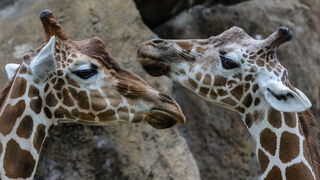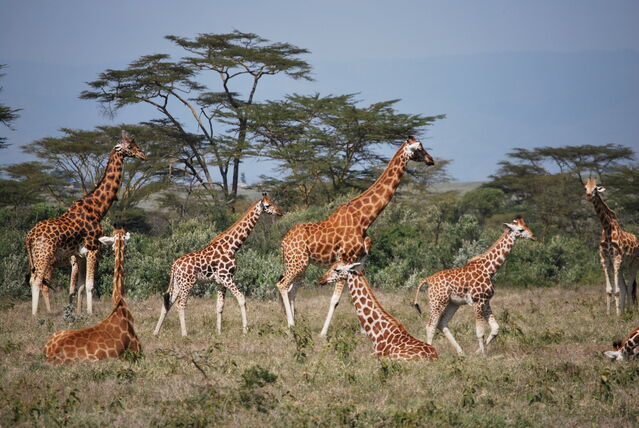Relationships
Giraffes May Be as Socially Complex as Orcas and Elephants
A new paper collects evidence that giraffes are a highly complex social species.
Posted August 10, 2021 Reviewed by Abigail Fagan
Key points
- Giraffes were once thought to have little or no social structure and form only temporary associations with one another.
- Recent research suggests that giraffes are a highly complex social species, potentially comparable to elephants and chimpanzees.
- Giraffes form matrilineal societies characterized by cooperation and long-lasting relationships.

“Giraffes are such oddball animals. If somebody told you they existed and you didn’t know about them, you would hardly believe it,” says Zoe Muller of the University of Bristol, who has studied giraffes for 20 years.
“When I first got interested in giraffes, I couldn’t believe that such an amazing and iconic creature had so few scientific studies devoted to it.”
Traditionally, giraffes were believed to have little or no social structure. Muller cites one research paper that described the giraffe as “socially aloof, forming no lasting bonds with its fellows and associating in the most casual way.”
This view began to change in the early 2000s, around the time that Muller started researching giraffes. At this time, social network analysis emerged as a new technique for studying animal interactions. Along with more sophisticated approaches to data analysis, the rise in digital camera technology also helped change the view of giraffe society. Giraffes are individually recognizable by their distinct coat patterns, so researchers could use digital photos to consistently and accurately keep track of which individuals were associating with one another. These technologies underpinned a resurgence of interest in giraffe behavior over the last 20 years — one that has turned our understanding of these giants on its head.
Sophisticated Social Lives
In a new paper, Muller and colleague Stephen Harris reviewed over 400 research papers and collected all the information available on giraffe behavior and social organization. The evidence they found paints a picture of an animal with a highly complex social system, potentially comparable to that of elephants, chimpanzees, and dolphins.

Giraffes appear to live in matrilineal societies, with adult females forming stable, close-knit groups within a home range. While males typically disperse by adulthood and become more solitary, female giraffes maintain long-term relationships with other females and their own offspring. These close relationships likely help protect the young from predators and create an environment in which offspring can learn social and survival skills from knowledgeable older animals.
Muller and Harris show that giraffes exhibit many of the features typical of mammals with complex cooperative social systems. However, there are still aspects of giraffe life that we know little about, such as their communication systems.
It is also still unclear if giraffes are cooperative breeders. Muller says there is some evidence suggesting that they cooperate during breeding. For instance, young calves are often cared for, and even nurse from, adults that are not their mothers, and females have been observed in apparent distress following the death of another individual’s calf. But without conclusive evidence that non-breeding helpers are a key feature of giraffe society, it is more appropriate to describe giraffes as having a complex cooperative social system than as being cooperative breeders.
Wisdom and Experience
Muller and Harris’ review also turned up some interesting insights into the role of older animals in giraffe society. Giraffes can live into their late twenties or early thirties, although the maximum reproductive age for females is about 20 years. This suggests that female giraffes spend up to 30 percent of their lives in a post-reproductive state. This is comparable to other species with highly complex social structures and cooperative care, such as elephants and killer whales.
The “grandmother hypothesis” posits that females live long past their reproductive years so that they can help raise successive generations of offspring. In species such as elephants and killer whales, it has been shown that the presence of post-menopausal females increases the survival of related offspring. Whether this is also the case in giraffes is a question for further research.

The role of older males in giraffe society is also not fully understood. Scientists do not know when their fertility stops and if they survive long past this point, nor how dominance between males impacts mating success. In some social species, such as elephants, the removal of older individuals is associated with impaired social and survival skills in the group.
“In southern Africa, it is common policy to cull or allow hunting of the oldest giraffes in the herd, because it is believed that since they are not reproducing anymore and no longer contributing genetically to the population, it does not matter if they are killed for population control or trophy hunting,” says Muller.
“However, the long-term population effects of selectively culling older giraffes are unknown.”
A Future for Giraffes
Muller says that recognizing the giraffe as a highly complex social species is essential to ensure its survival.

“I think everybody just expects that giraffes will be here forever,” she says. “They are such a symbol of Africa. And they are well-known throughout the world: Even when we’re in nursery we learn that ‘G is for Giraffe.’
“People take it for granted that giraffes will always be here, but actually, they are under real pressure in the wild.”
Giraffe numbers have declined by 40 percent in the last 30 years and they have been declared extinct in seven (possibly nine) countries. Giraffes are listed as Vulnerable by the International Union for Conservation of Nature.
“Giraffes have been undergoing this silent decline,” says Muller. “If conservation actions are not taken, it is a very real possibility that they may not be here in 50 to 75 years.”
References
Muller Z and Harris S. (2021). A review of the social behaviour of the giraffe Giraffa camelopardalis: a misunderstood but socially complex species. Mammal Review. First published: 02 August 2021. Doi: 10.1111/mam.12268.



